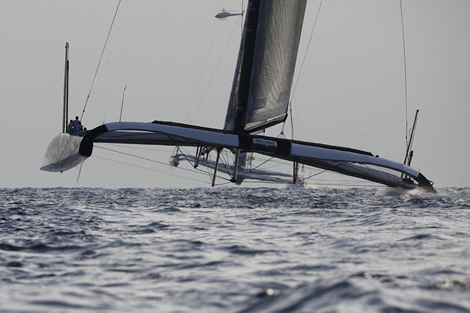While this is indeed the most compelling argument I have read for bringing the America’s Cup to Newport, there is a very big difference between One boat using Newport as a base and an America’s Cup event. An America’s Cup event in Newport would disrupt life here in ways we cannot imagine. I much prefer to see boats being built and launched here.
Can Newport and the state of Rhode Island afford to spend the money to bring the Cup here? Do the numbers really make sense? Will it really increase employment in a meaningful way? Not just part time jobs.
COULD THIS BE NEW ENGLAND’S BEST CHRISTMAS EVER?
Ken Read is a resident of Newport and is the CEO and Skipper of PUMA Ocean
Racing – a sailing team built to participate in the Volvo Ocean Race. He is
also the Vice President of North Sails Group LLC. Here he shares his
excitement on the possibility of the America’s Cup coming to his town:
———————————————————————-
Rhode Island needs the America’s Cup, and has the opportunity within its
grasp to do so. An amazing last minute organizational effort between many
different state and private organizations has made Rhode Island a front
runner in the race to be the venue for the 2013 America’s Cup.
At first glance it would appear that I am the most biased person in the
state to write an editorial in support of the America’s Cup coming to Rhode
Island. I grew up in this area, and have sailed on Narragansett Bay my whole
life. I moved to Newport in the infamous summer of 1983 and witnessed
firsthand the removal of the America’s Cup from our shores. Since then I
have had the good fortune to be a part of dozens of world class sailboat
racing teams including skippering Dennis Conner’s America’s Cup bids on two
separate occasions.
Over the past three years I have served as the CEO and Skipper of PUMA Ocean
Racing, the Volvo Ocean Race entry of the sports-lifestyle company PUMA. The
Volvo Ocean Race is considered as one of the big three sailing events in the
world, along with the Olympics and the America’s Cup.
I am proud to say that PUMA Ocean Racing is the second largest professional
sailboat racing team in the United States, second only in size and success
to BMW-Oracle Racing, the holder of the America’s Cup. Like all professional
teams we had a choice on where we wanted to organize, train and build our
program. We chose Rhode Island.
Why did we choose Rhode Island?
First of all, Rhode Island has a marine trade industry that helped us create
a racing program that can successfully compete against the best in the
world.
Secondly, we can keep the construction, design and engineering of our
programs major components literally within driving distance of our
waterfront base, located at the Newport Shipyard since 2007.
And finally, we are a five-minute sail from some of the best sailing grounds
in the world that we use for training, testing and racing.
What does this all mean to the State of Rhode Island? Thanks to these three
major attributes PUMA Ocean Racing has spent over 20 million dollars in
Rhode Island in the past three years. This sum has covered the fundamental
components’ of a program our size such as design and engineering, boat and
mast construction, sails, rigging, housing, and food. Not to mention the
influx of cash that our employees and their families spend to live their
daily lives. And this is money that represents a few cents on the dollar
compared to what the America’s Cup would bring to the region.
My point takes a twist though, and I sincerely hope that our governmental
leaders and citizens understand a second crucial point. The decision to
spend money on infrastructure to lure the America’s Cup has very little to
do with the sport of sailing as a whole, and has everything to do with good
business. — Read on:
http://forum.sailingscuttlebutt.com/cgi-bin/gforum.cgi?post=11021


